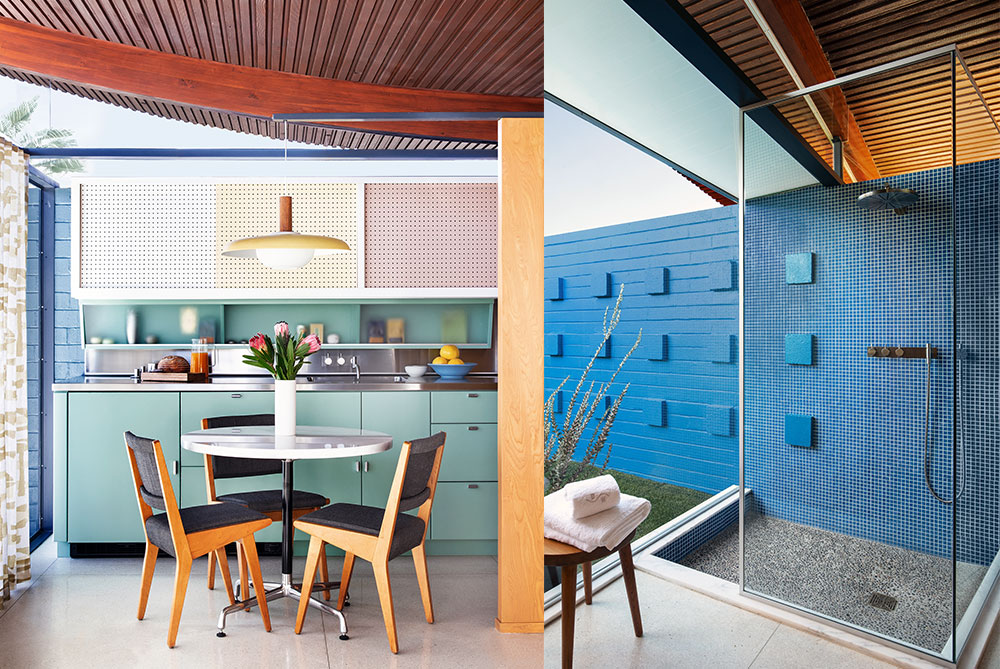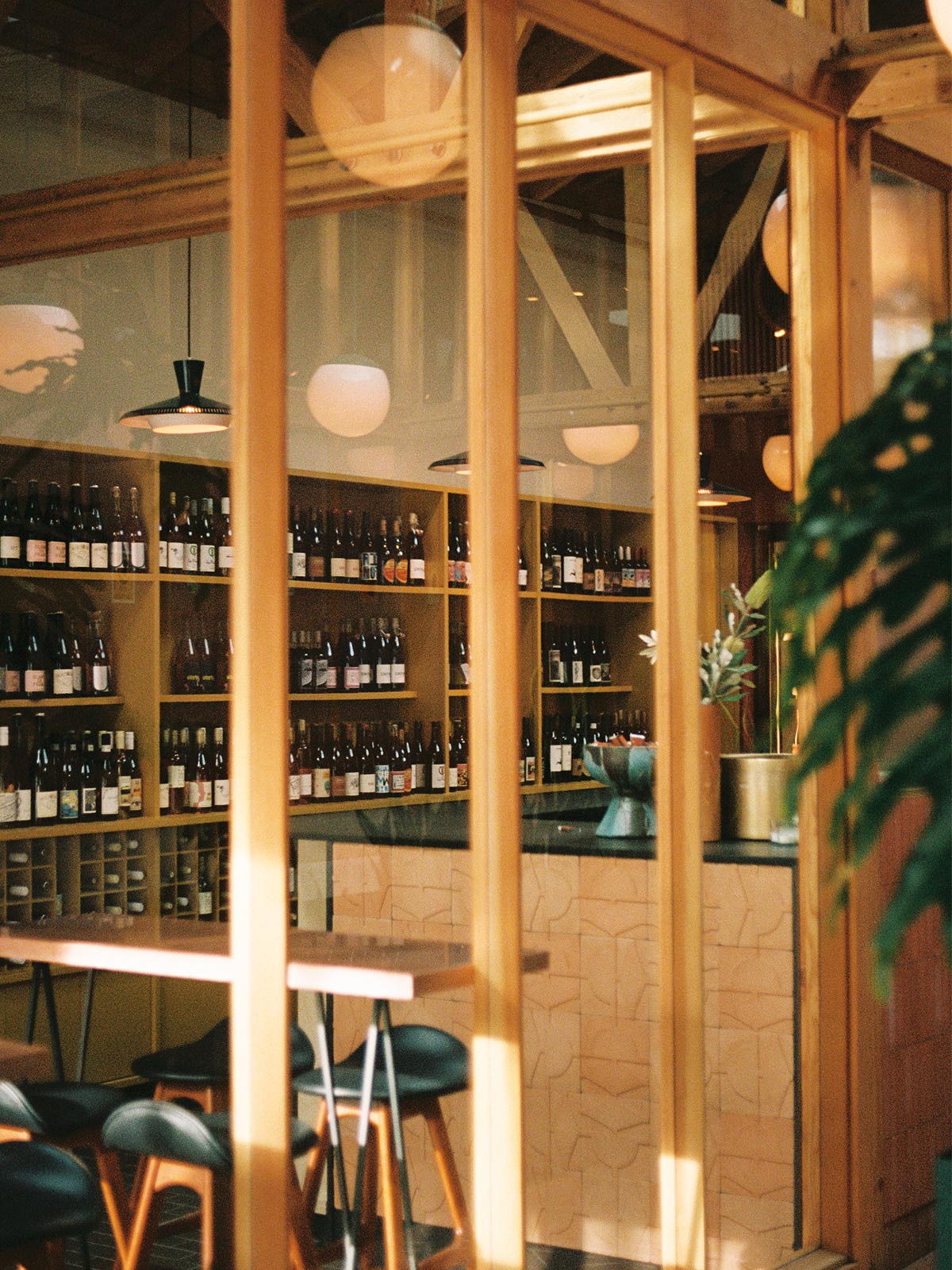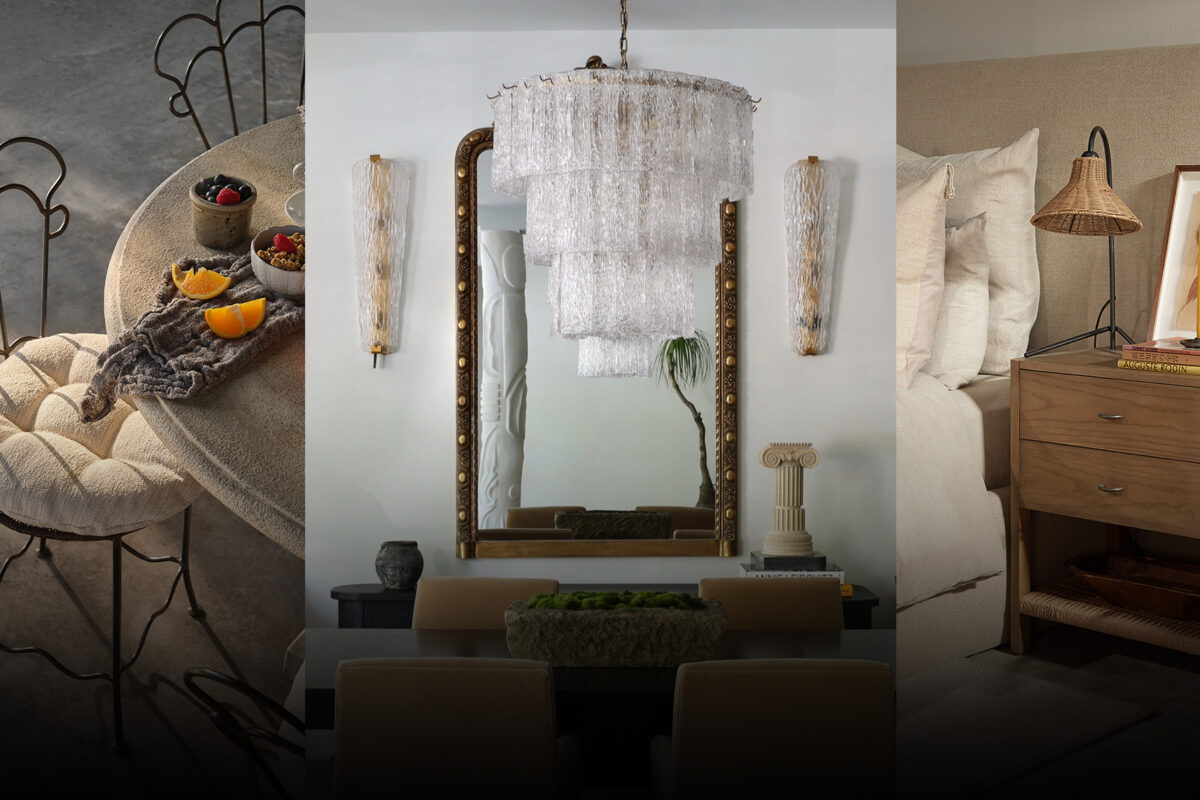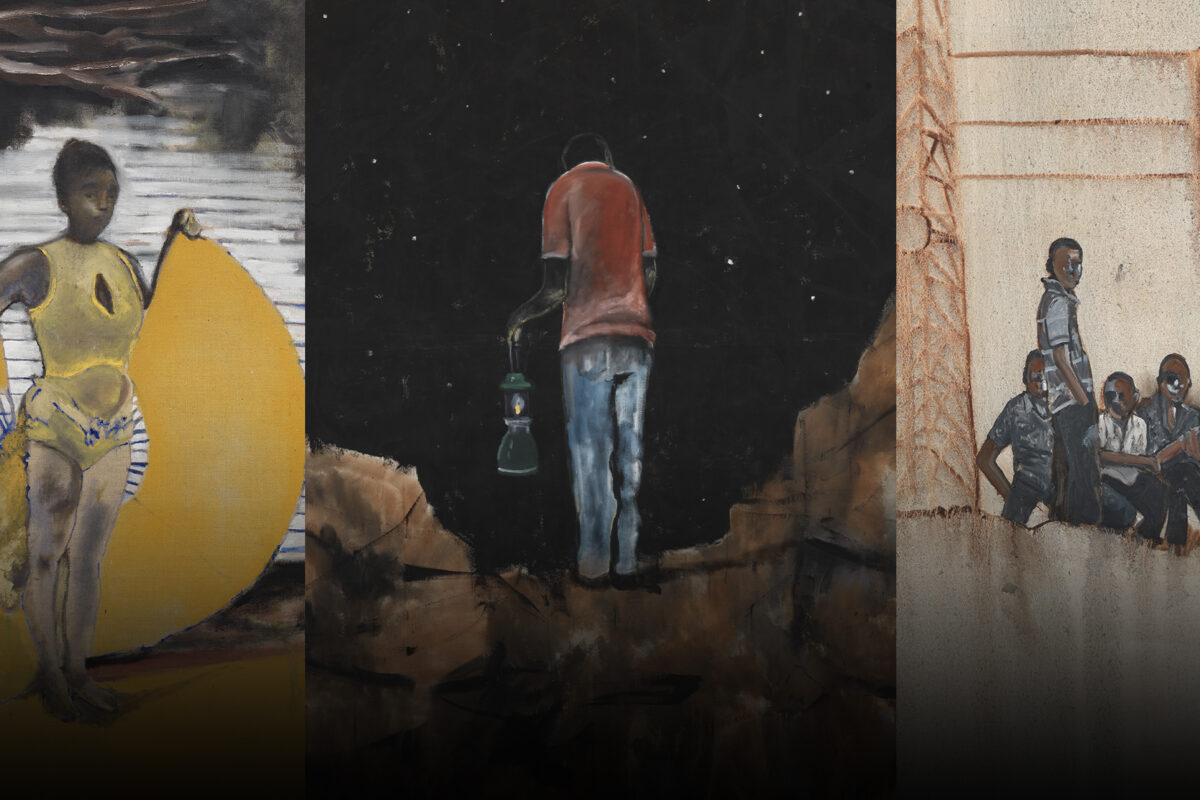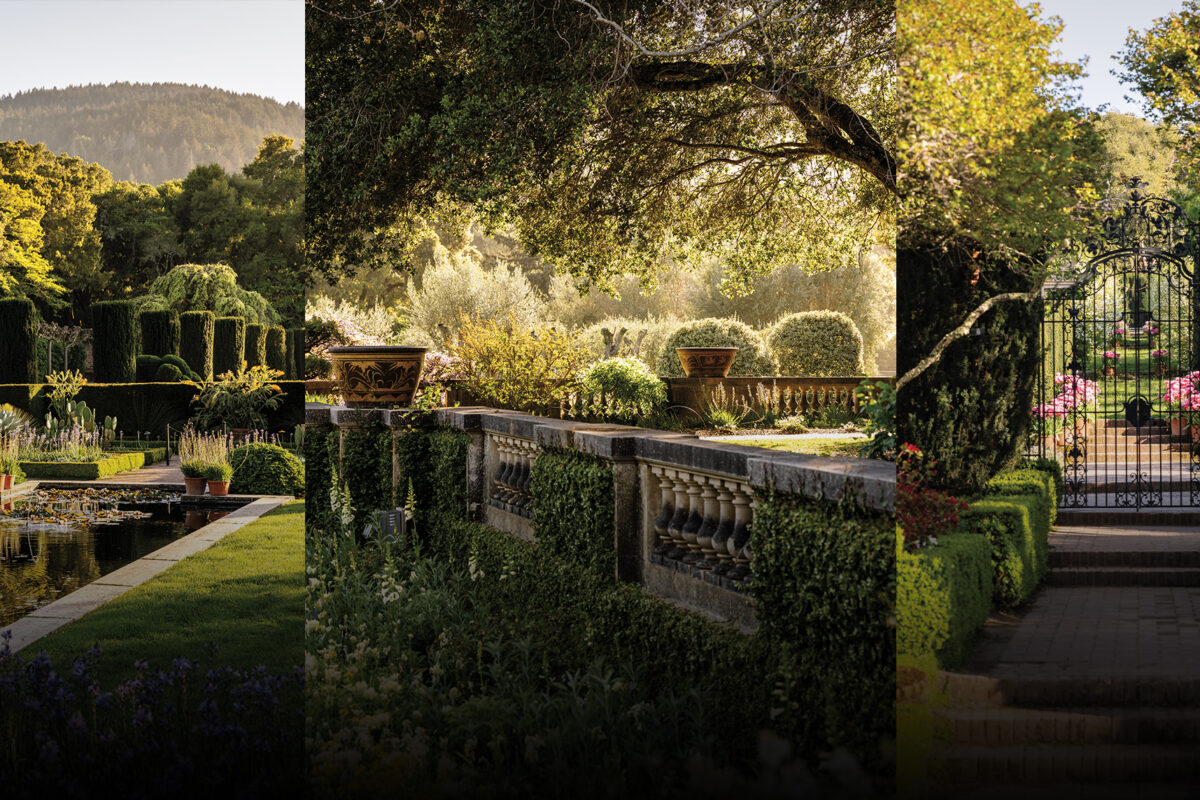The SoCal design firm of the moment on opening its Wave House and designing for life after the pandemic
Words by MELISSA GOLDSTEIN
When Christian Stayner, founder and principal of forward-thinking Los Angeles firm Stayner Architects, first set eyes on the Wave House in Palm Desert, there was an immediate attraction to the experimental structure, named for its curvilinear roof. Designed by modernist architect Walter S. White in the 1950s for artist Miles C. Bates, the house has, in Stayner’s words, “a sort of jolie-laide quality, an unconventional beauty — like Adrien Brody or Anjelica Huston.” This, in spite of the fact, he adds, that when he snapped it up at auction in 2018, “the special qualities of the house had been covered and hidden with layers of drywall and paint and faux finishes.”
CHRISTIAN STAYNER, founder and principal of forward-thinking Los Angeles firm STAYNER ARCHITECTS, stands before a separate structure on the grounds of the Wave House. Photo by Monica Orozco.
Stayner set about restoring it to its former glory, with the vision to reopen it as a micro-boutique hotel, one of several intimate and stylish recent hospitality projects for the firm: There’s Echo Park’s natural wine bar, Tilda — currently fulfilling contactless orders — neighboring yet-to-open Italian restaurant Etti, LGBTQ co-working space Parrot House, and another mostly outdoor restaurant in the same neighborhood in the works.
“Wave House has an unconventional beauty — like Adrien Brody or Anjelica Huston”
CHRISTIAN STAYNER
Having debuted at Palm Springs Modernism Week in February, the Wave House is now taking weekend bookings for July through the end of the year. As Stayner explains, it just might present the perfect escape for Californians: “It’s a chance to get away from the city and to have this almost time-travel experience in which you’re able to leave behind the mess of the world. The house is isolating in the best possible way: to listen to music on the vintage speakers, flip through Life magazines that were my grandfather’s, go for a bike ride or hike in the nearby hills, soak in the hot tub and use the shower that looks out into a private cactus garden.” And, he adds: “These weekend escapes also mean that the house sits empty throughout the week and is heavily sanitized between visits; it’s sort of a bubble to retreat to.”
We spoke to Stayner about what hospitality means now, the pitfalls of preservation and natural wine in unnatural times.
How would you characterize your restoration philosophy regarding the Wave House?
To be honest, we are fairly skeptical about historic preservation. We care deeply about history; architecture is all about history. Every architect who has ever moved the discipline forward has done so through a thoughtful, rigorous engagement with the past. Preservation as it is currently practiced in the U.S. is really the opposite of reimagining the future — it’s about controlling the past, trying to place everything precisely back in an idealized place, completely backward-looking. In terms of how we approached the Wave House restoration, we made a very determined effort to balance between the original architectural intent as well as acknowledging the passage of time.
Entering the Wave House is akin to stepping back into the 1950s. Photo by Tim Hirschmann.
Do your plans for a hotel include adding on to the structure?
Now that the house is completed, we are beginning construction on the next phase of the project: Adding two additional one-bedroom units, a pavilion that holds a catering kitchen for events and a room for screening movies or holding small meetings, a large pool, and extensive landscaping.
What adaptations are you thinking about for your hotel in a world after COVID-19?
To us, hospitality is producing spaces and environments for people to gather together. Doing that with sterility — gloves and masks and plexiglass — is just not the right approach for us. Instead, we see these new conditions as a design challenge: Normally, there are a variety of sensory and design moves that we can combine to produce a specific experience: the smell of walking into a space; the temperature and humidity; lighting levels, quality, and color; music and ambient sounds; materials, etc. Now we have much more limited means since people can’t eat on-site: the ordering and pickup sequence, the packaging, the other inventions we can make that transport people somewhere else, if only temporarily.
The midcentury kitchen. A shower restored with blue tile made to match the original. Photos by Tim Hirschmann.
And for your other projects?
Our architecture practice has also been working with businesses to think about how to respond to the new conditions created by the pandemic — not in a reactionary way and not with seemingly simple fixes. We’ve released two thoroughly researched publications, one for brick-and-mortar businesses to creatively think about their operations beyond the pandemic, as well as a document presenting ideas for how restaurants can respond to the new conditions. While we would all like to turn back the clock, it’s not going to happen at least immediately. So we need to be creative in designing the future.
TILDA wine bar. Photo by Jon Anthony.
Turning to Tilda, your wine bar, what is the concept and what should we be drinking?
Tilda’s passion is natural California wine, specifically independent farmers and small producers across The Golden State. We just debuted a monthly club called Supernatural. For May, our first month, we focused on wines made by a group of makers dubbed “the natural wine mavericks of Santa Cruz” [James Jelks of Florez Wine Co., Megan Bell of Margins Wine, Brent Mayeaux of Stagiaire Wine, and Ryan Stirm of Stirm Wine Co.]. These are tiny but serious solo producers in their late 20s and early 30s. They share an industrial space in Santa Cruz and buy, barter or grow their own grapes in neighbor’s backyards or from small agricultural outfits. Large growers won’t talk to these guys and gals, so they’ve adopted grape varietals that are overlooked or grapes that are grown on the edges of larger vineyards. The June release is really exciting as the focus is on our immediate neighbors in Los Angeles, which was the epicenter of U.S. wine production back in 1917 — this was around the time of the [1918 flu] pandemic and leading up to Prohibition from 1919 to 1933, which destroyed the industry in Southern California.
What is the hottest talking point right now when it comes to the subject of sustainability in architecture?
The pandemic has exposed a lot of really big, really important structural problems — from potentially irreversible impacts we’ve had on the earth, to enormous income inequality, to the precariousness of the people who do the majority of labor that makes our comfortable lives possible.
You’re saying sustainability issues are more complex than maybe some people realize.
The dirty fact of architecture is that it’s often more sustainable to simply not build anything at all. But that puts us out of work. The environmental and labor costs of construction mean that we have to be incredibly careful about what we do build and how we do it. Sustainability requires a lot more than slapping the word “green” onto something, although frankly it’s much easier to sell a client on a single material being “green” and therefore virtuous, or to add a “smart technology” device that presents a simple solution.
TILDA’s brick exterior (left) and indoor seating against ochre-colored walls. Photos by Tim Hirschmann.
How are you specifically approaching these matters?
What we’ve been working on in our architectural work and in development is a more precise definition of sustainable. Specifically, we’ve been focusing on three core sustainability concerns: materials usage, just and equitable labor and impact architecture — our term for architecture and development that attempts to produce meaningful social and environmental benefits.
Who are the sustainability standard bearers in California?
Sadly, I think you need to look beyond architecture right now. Equity Community Builders in San Francisco is a developer that partners with nonprofits. Nature Coatings is a company in Los Angeles that is recycling wood waste into pigments for construction and textile.
Among TILDA’s vintages you will find natural California wine by independent farmers and small producers. Photo by Jon Anthony.
What are your visions for California’s future in terms of housing?
Combining commercial with residential, light industrial uses with restaurants, schools abutting stores and offices. Buildings and spaces that change use from one point in the day to another, or neighborhoods that can balance day and night uses. This is way beyond “mixed-use development,” which tends to mean bland apartments above a Starbucks or a bank branch that the developer subsidizes in order to lure renters in with amenities. The future of housing in California is only going to be possible if we move past the antiquated zoning laws that require every lot to be 5,000 square feet or greater and zoned residential and that many miles away is “commercial” zoning where people can work. That’s not the reality now, and it’s not where things are headed.
What do you hope to see more of in architecture this year and moving forward?
What we want to see happen is that architecture actually significantly changes in response to this public health crisis. Historically, pandemics have brought about new forms of public space, a willingness to incorporate new materials and new building types that reconfigured human habitation. These are the efforts we’re putting our creative attention toward. We don’t know the outcomes.
Feature image: The Wave House in Palm Springs. Photo by Tim Hirschmann.
May 28, 2020
Discover more DESIGN news.



